The March quarter 2013 report from the Australian Government ABARES (Australian Bureau of Agricultural and Resource Economics and Sciences) report states that over the medium term to 2017–18 the value of Australian fisheries production is projected to increase by $50million (2.1per cent) to $2.45billion (in 2012–13dollars).
Fisheries Production Projected to Grow Over the Medium Term
The gross value of Australia’s fisheries production is forecast to rise by 1 per cent to $2.4 billion in 2012–13.
The real value of Australian fisheries production declined significantly over the past decade, attributable to a decrease in the value of production of some higher value species groups, such as rocklobster, prawns, abalone and tuna. Over this period farmed salmonids production increased, with growth offsetting some of the decline in the wild-catch sector.
Over the medium term to 2017–18 the value of Australian fisheries production is projected to increase by $50 million (2.1 per cent) to $2.45 billion (in 2012–13 dollars).
World Consumption and Trade of Seafood Steadily Rising
Global seafood consumption continues to rise, reaching 128.3 million tonnes in 2010, largely a result of rising population and an increase in per person consumption FAO (2012a). On a per person basis, average global consumption of fish increased from 9.9 kilograms (live weight) in the 1960s to an estimated 18.4 kilograms in 2009 (FAO 2012a, b). The highest growth was in China, where per person seafood consumption increased from 11.5 kilograms per year in 1960 to 31.9 kilograms in 2009 (FAO 2012a, b). In Australia consumption is higher than the global average, at 25.2 kilograms per person in 2009. In Australia’s major export destinations for seafood, consumption per person is also higher than the global average, with the highest per person consumption in Hong Kong (71.6 kilograms in 2009), followed by Japan (54.5 kilograms), Singapore (46.5 kilograms), China (31.9 kilograms) and the European Union (23.0 kilograms).
Global growth in seafood consumption is being increasingly met from aquaculture production. Seafood production from aquaculture rose by 73 per cent between 2001 and 2010, from 34.6 million tonnes to 59.9 million tonnes, increasing its share of global seafood production from 35 per cent to 46 per cent over this period. Globally, most aquaculture seafood production—89 per cent by volume—comes from Asia. For example, China alone contributed about 61 per cent to global seafood aquaculture production in 2010. Other large aquaculture seafood producers include India, Vietnam, Indonesia and Bangladesh (FAO 2012a). A large increase in aquaculture seafood production of species such as shrimps, salmon, bivalves, tilapia, catfish and basa has led to the decrease in their prices and a strong increase in their commercialisation (FAO 2012b).
Fishery Products Per Person Supply 2009 a
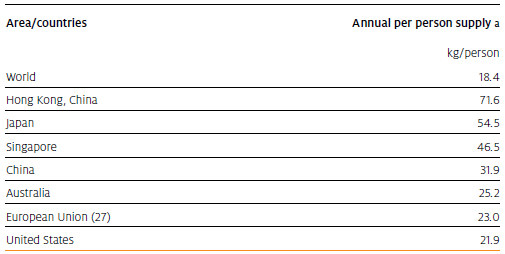
Source: FAO 2012a
Seafood Production from Wild-catch and Aquaculture, 2001 to 2010
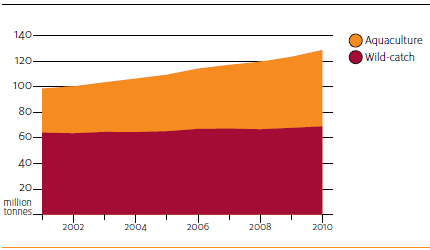
Fish and fisheries products are highly traded commodities. The international trade in fishery commodities has been growing steadily over the past decade, with the highest increase in the value of exports from China, Thailand and the Netherlands. In 2010 world exports amounted to US$109.3 billion with China taking the highest share, contributing US$13.3 billion (12 per cent), followed by Norway (8 per cent, US$8.8 billion), Thailand (7 per cent, US$7.1 billion) and Vietnam (5 per cent, US$5.1 billion) (FAO 2012a). Preliminary estimates indicate that the value of exports exceeded US$125 billion in 2011 due to increasing prices and strong demand in developing countries (FAO 2012b). In volume terms, fishery exports represent around 38 per cent of world fisheries production.
Major importing regions in 2010 included the European Union where imports reached US$44.6 billion, representing 40 per cent of total world imports, although most of the trade occurred between European Union members (FAO 2012a). The United States and Japan were net importers of fishery products in 2010 with imports representing more than half of their fishery consumption, amounting to US$15.5 billion and US$14.9 billion, respectively. China has significantly increased fishery imports in recent years, with imports of US$6.2 billion in 2010, compared with US$4.5 billion in 2007.
Australian Fisheries Production and Trade
Production
Over the decade to 2011–12 the gross value of Australia’s fisheries production (GVP) fell by 26 per cent in real terms to $2.43 billion. The fall in production value over this period was driven by an appreciation of the Australian exchange rate, which lowered average beach prices for many of Australia’s key fishery export products, and lower production volumes of rocklobster. The decline in production value over this period was moderated by the strong growth in production volume of salmonids, particularly since 2004–05. Salmonids production is estimated to increase its share of the value of Australian fisheries production from 7 per cent in 2004–05 to 22 per cent in 2011–12.
In contrast to other key export products, the price for rocklobster has increased since 2004–05 due to increased demand on international markets. Much of the decline in its production value is due to lower production. Over the past decade the combined value share of the four main export species—rocklobster, tuna, prawns, and abalone—to total Australian fisheries production declined from 61 per cent to 43 per cent.
Australian salmonids are estimated to account for 18 per cent of Australian fisheries production by volume in 2011–12 (43 985 tonnes), followed by prawns (22 877 tonnes, 10 per cent), oysters (14 897 tonnes, 6 per cent) and tuna (10 901 tonnes, 5 per cent).
Real Value of Australian Fisheries Production, by Key Species Group, 2001–02 to 2011–12
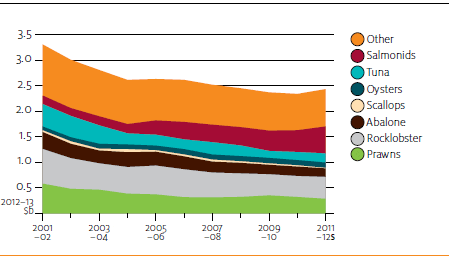
Note: Rocklobster production value includes Queensland bugs.
Average Prices of Key Australian Species, 2000–01 to 2010–11
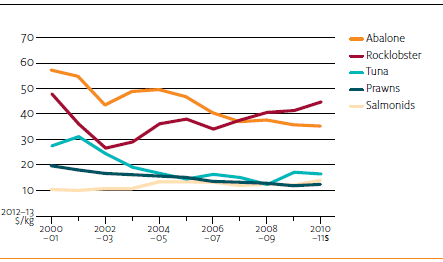
Wild-catch sector
In 2000–01 the wild-catch sector accounted for around 72 per cent of the gross value of fisheries production. Over the decade to 2010–11, the production value of the wild-catch sector declined by 46 per cent ($1.1 billion) in real terms. The largest declines occurred for prawns ($289 million), rocklobster ($252 million), abalone ($201 million) and tuna ($111 million). The wild-caught production volume decreased by 17 per cent (32 938 tonnes) (Skirtun et al. 2012).
State fisheries (generally classified as fisheries adjacent to each state and/or territory within three nautical miles of the coastline) accounted for 76 per cent of GVP in 2010–11. The remaining 24 per cent was from Commonwealth fisheries (generally between three and 200 nautical miles from the coastline—the Australian Fishing Zone). In value terms, the largest jurisdiction in the wild-catch sector in 2010–11 was the Commonwealth, accounting for 24 per cent of the total value of Australian wild-catch fisheries ($320.4 million), followed by Western Australia ($284.6 million, 22 per cent), South Australia ($195.4 million, 15 per cent), Queensland ($188.5 million, 14 per cent) and Tasmania ($164.9 million, 13 per cent). Together these jurisdictions accounted for 88 per cent of the production value of Australia’s wild-catch fisheries.
Aquaculture Sector
The gross value of aquaculture production increased by 1 per cent (in real terms) to $948.1 million from 2000–01 to 2010–11, with most of this growth occurring since 2004–05, growing by 25 per cent since then. The value of aquaculture production declined over the period 2000–01 to 2004–05. This was predominately as a result of lower export earnings from tuna aquaculture and strong appreciation of the Australian dollar exchange rate. The share of aquaculture in total fisheries value increased from 29 per cent in 2000–01 to 43 per cent in 2010–11.
Since 2004–05 a significant increase has occurred in production of salmonids in Tasmania; it has more than doubled in volume terms. The value of farmed salmonids increased by 11 per cent in 2010–11 to $408.8 million. In 2010–11, salmonids accounted for 47 per cent in volume terms of total Australian aquaculture production.
Farmed tuna production consists solely of farmed southern bluefin tuna from South Australia. In 2010–11 farmed tuna production increased by 22 per cent to $125.2 million, accounting for 13 per cent of the total value of Australian aquaculture production. The farming of southern bluefin tuna involves transferring juvenile fish caught in the Commonwealth Southern Bluefin Tuna Fishery to farms in South Australia for maturation and fattening.
Real Value of Fisheries Production, by Sector, 2000–01 to 2010–11
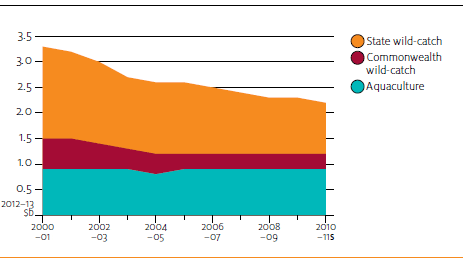
Note: To avoid double-counting, the aquaculture total was adjusted to exclude southern bluen tuna caught in the Commonwealth Southern Bluen Tuna Fishery, which was input to farms in South Australia.
Trade
Australian fisheries exports are dominated by high value products, such as rocklobster, pearls, abalone and tuna. In real terms, the value of Australian fisheries exports fell by 56 per cent between 2001–02 and 2011–12 to $1.2 billion. The main factors contributing to this decline were a 37 per cent decline in the volume of edible exports and falling unit prices for some major export species, particularly prawns and abalone.
Real Value of Australian Fisheries Exports and Imports, 2001–02 to 2011–12
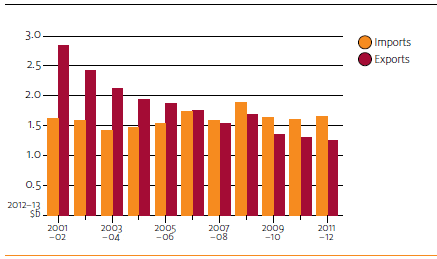
In 2011–12 rocklobster remained the most valuable export product by value ($386.6 million), followed by pearls ($206.6 million), abalone ($197.3 million), tuna ($162.7 million) and prawns ($65.3 million). These products together accounted for 83 per cent of the Australian total export value of fisheries products in 2011–12.
In 2011–12 Australia’s major fishery (edible) export destinations in value terms were Hong Kong ($448.7 million), Japan ($254.9 million), China ($58.5 million), Singapore ($42.6 million) and the United States ($22.7 million). These countries accounted for 67 per cent of the total value of Australian fishery exports. Hong Kong was the largest market for exports of rocklobster, valued at $290.9 million and accounting for 75 per cent of exports, and abalone, scallops and oysters, taking 52 per cent ($101.6 million), 53 per cent ($8.3 million) and 64 per cent ($4 million) share of the total export value of these products, respectively. Japan is Australia’s main export destination for whole tuna, prawns and salmonids, accounting for 97 per cent ($157.9 million), 44 per cent ($29 million) and 34 per cent ($14.3 million) of exports of these products, respectively. China, Taiwan, Singapore and the United States are also important markets for Australian abalone and rocklobster.
Major Export Destination Markets for Fishery Products, 2001–02 to 2011–12

In 2011–12 the value of Australian fisheries imports was valued at $1.6 billion. The major imported edible products in 2011–12 were prawns ($350.9 million), tuna ($204.8 million) and salmon ($91.8 million), including prepared and preserved products. The major sources for Australian edible imports in 2011–12 were Thailand (23 per cent), China (14 per cent), New Zealand (12 per cent) and Vietnam (11 per cent).
Australian Fisheries Medium-term Outlook (Major Products)
The value of Australia’s fisheries production is forecast to rise in 2012–13, by 1 per cent to $2.4 billion. Most of this growth is attributed to an increase in salmonid production, forecast to grow by 5 per cent to reach $540 million. The production value of key export species is also forecast to rise, with the value of tuna, prawns and rocklobster increasing most, 4.8 per cent, 3.6 per cent and 0.5 per cent, respectively.
The assumed high value of the Australian dollar over the medium term will continue to constrain new export opportunities for key production species. Any reduction in the value of total production in the wild-catch sector is likely to be offset to some extent by continued increase in the value of aquaculture production, particularly salmonids. The value of Australia’s fishery product exports is projected to remain fairly stable, at around $1.2 billion a year over the medium term.
Prawns
Wild-caught prawns, predominantly sourced from the northern waters of Queensland and the Northern Territory, accounted for around 80 per cent of total Australian prawn production in 2011–12. However, aquaculture is contributing a growing share of prawn production, with its share growing to 20 per cent in 2011–12 from 13 per cent in 2001–02. Most aquaculture prawn production occurs in Queensland, which produced 4300 tonnes in 2011–12, with a value of $64 million.
In 2011–12 total prawn production is estimated to have decreased by 15 per cent to 22 877 tonnes. This decrease is largely attributed to lower catch volumes of wild-caught prawns in the Northern Prawn Fishery, where the banana prawn catch decreased by 36 per cent to 4900 tonnes, and South Australia, where production declined by 14 per cent to 2000 tonnes. The value of prawn production declined by 9 per cent in 2011–12 to $277 million. In 2012–13 the value of prawn production is forecast to increase by 3 per cent to $287 million, reflecting the effect of higher domestic prices.
Compared with 2012–13 the real value of prawn production is projected to fall by 4 per cent to $276 million in 2017–18. This is despite a projected increase in the volume of prawn production, increasing by 8 per cent to reach 24 305 tonnes by 2017–18. Real prices received by prawn producers are projected to decline, largely as a result of the assumed relatively high value of the Australian dollar, and strong competition in the domestic market from imported prawns.
The value of prawn exports decreased by 15 per cent in 2011–12 and export volumes fell by 18 per cent. In 2012–13 the value of prawn exports is forecast to decline by a further 25 per cent, as domestic producers continue to redirect product to the domestic market. Toward 2017–18 the value of prawn exports is projected to recover, increasing by 3 per cent to reach $50.5 million by 2017–18 (in 2012–13 dollars) as a result of higher production volumes.
Rocklobster
Western Australia accounts for most of Australia’s production of rocklobster, contributing 56 per cent of Australia’s total production (by volume) in 2011–12. The other two main rocklobster fisheries, located in South Australia and Tasmania, accounted for 16 per cent and 11 per cent of total catch in 2011–12, respectively. In 2011–12 Western Australia, South Australia and Tasmania accounted for 48 per cent, 23 per cent and 15 per cent of Australia’s gross value of rocklobster production, respectively.
In recent years total Australian rocklobster production has declined considerably (estimated to be 9980 tonnes in 2011–12), compared with the 2003–04 peak production of 19 344 tonnes. The main reason for the decline has been a large reduction in catch in Western Australia, which has been capped by individual transferable quotas at 5500 tonnes. This compares with a peak catch of 13 744 tonnes in 2003–04.
The bulk of production is exported, predominantly to Hong Kong and China. Production and exports over the medium term are expected to remain stable with the three major rocklobster producing states now being managed under a system of total allowable catch and individual transferable quotas. However, in 2012–13 Tasmanian production is forecast to fall by 14 per cent, to 940 tonnes, due to an algal bloom outbreak causing fishery closures in some rocklobster producing areas, but projected to recover over the medium term.
In 2011–12 the value of rocklobster production increased by 7 per cent to $416 million following a strong increase in unit values, which increased by 9 per cent in the year. In 2012–13 the value of rocklobster production is forecast to rise slightly to $418 million. Real unit values are projected to decrease over the medium term, albeit moderately. As a result, the real value of production is projected to fall to $415 million by 2017–18 (in 2012–13 dollars).
Abalone
A total of 4817 tonnes of abalone was harvested in Australia in 2011–12, not including Victorian aquaculture production which was confidential. Around 83 per cent of this came from wild-catch fisheries in Tasmania, Victoria and South Australia. Since its detection in 2005, the Abalone Viral Ganglioneuritis disease has significantly reduced abalone production in the Victorian wild-catch sector. Production levels are expected to gradually recover over the medium term. Australian abalone production, not including Victorian aquaculture, is forecast to be slightly lower at 4708 tonnes in 2012–13. Australian abalone production (excluding Victoria) is projected to increase by 5 per cent to around 4934 tonnes by 2017–18. Victorian aquaculture production has been excluded in these calculations due to confidentiality.
While most abalone comes from wild-catch there has been a growing trend in aquaculture production. The abalone aquaculture sector in Tasmania, South Australia and Victoria has grown by more than 60 per cent since 2006–07, and accounted for 15 per cent of total production in 2011–12. Total Australian aquaculture abalone production is forecast to grow strongly over the medium term to 2017–18.
Australia exports around 60 per cent of its abalone harvest. Most abalone exports are destined for Hong Kong and China. Over the medium term it is expected that prices will improve in real terms, in line with an assumed depreciation of the Australian dollar exchange rate. Production (excluding Victorian aquaculture) and export values are projected to reach $191 million and $206 million, respectively, in 2017–18.
Tuna
Approximately three-quarter of Australia’s tuna production is exported, mostly to Japan and the United States, and increasingly to Thailand and the South Pacific. The principal tuna species in value and volume terms is southern bluefin, which is caught using purse seine methods from Commonwealth waters and then fattened in farms near Port Lincoln in South Australia. Other important export tuna species are yellowfin, bigeye and, more recently, albacore, caught predominantly in the Commonwealth Eastern Tuna and Billfish Fishery.
In 2011–12 the Southern Bluefin Tuna Fishery and the Eastern Tuna and Billfish Fishery are estimated to have accounted for 65 per cent and 25 per cent, respectively, of the total production volume of tuna. In 2011–12 Australian tuna production increased by 19 per cent to 10 901 tonnes. The southern bluefin tuna farm production increased by 23 per cent in volume terms in 2011–12, while the production volume of the Eastern Tuna and Billfish Fishery decreased by 12 per cent.
The value of tuna production increased by 16 per cent to $173.5 million in 2011–12 driven by volume increases. Of this, $151 million (87 per cent) was attributable to southern bluefin tuna production, with most of the remainder (11 per cent) attributable to the Eastern Tuna and Billfish Fishery. Yellowfin tuna was the principal species caught in the Eastern Tuna and Billfish Fishery, accounting for 64 per cent of the total value of production in the fishery. In 2012–13 the value of tuna production is forecast to increase by 4 per cent, to $181 million, driven by increased production levels.
Over the medium term Australian production and export volume of tuna are expected to steadily increase. This will be driven mainly by the recent increase in Australia’s total allowable catch allocations of southern bluefin tuna for the 2013 and 2014 fishing seasons. However, the value of production and exports are projected to decline by 15.3 per cent (to $153 million) and 12.3 per cent (to $148 million) by 2017–18 as a result of projected declining prices, influenced by the assumed steady appreciation of the Australian dollar against the Japanese yen over this period.
Salmonids
Salmonids are a key production species of Australian aquaculture, producing 43 985 tonnes in 2011–12. Around 98 per cent of the total Australian salmonids production occurs in Tasmania, where most production is sold to the domestic market. The remainder of salmonids production generally occurs in Victoria and New South Wales. In 2011–12 Tasmania produced 43 249 tonnes and Victoria produced just over 500 tonnes.
Tasmanian producers sell most of their salmonids on the domestic market whose annual consumption continues to grow. Despite this, producers face competition from imported product, particularly in recent years as a result of appreciation of the Australian dollar exchange rate. The value of salmonids production increased by 21 per cent to $516 million in 2011–12. This increase was driven mainly by a 21 per cent increase in Tasmanian production. The return of Chilean salmon to the international market, after a disease outbreak curtailed production in recent years, caused a decline in global salmon prices in 2011–12. In 2012–13 a further production increase is forecast and the value of salmonids production is forecast to increase by 4 per cent to $540 million.
Over the medium term it is projected that Australian salmonids production will rise by almost 19 000 tonnes by 2017–18, reflecting an anticipated production expansion of 40 per cent in the Tasmanian sector. As a result, the value of production is projected to increase by 21 per cent over the medium term to $654 million in 2017–18 (in 2012–13 dollars).
May 2013



